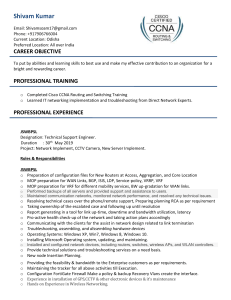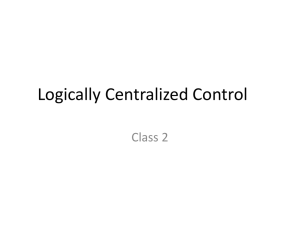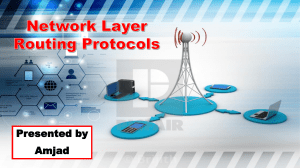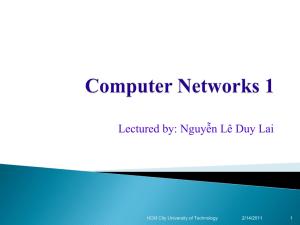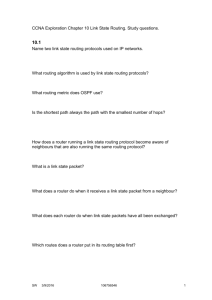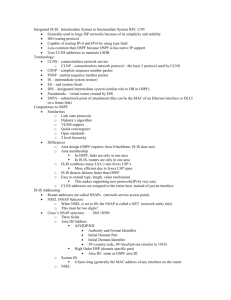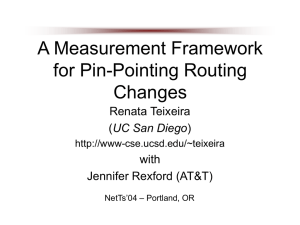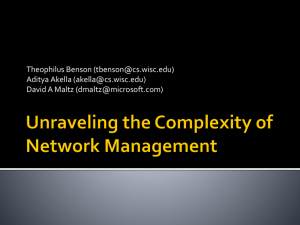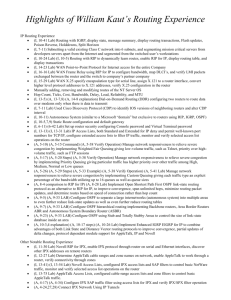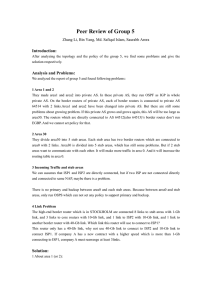NetworkDesign...cont
advertisement
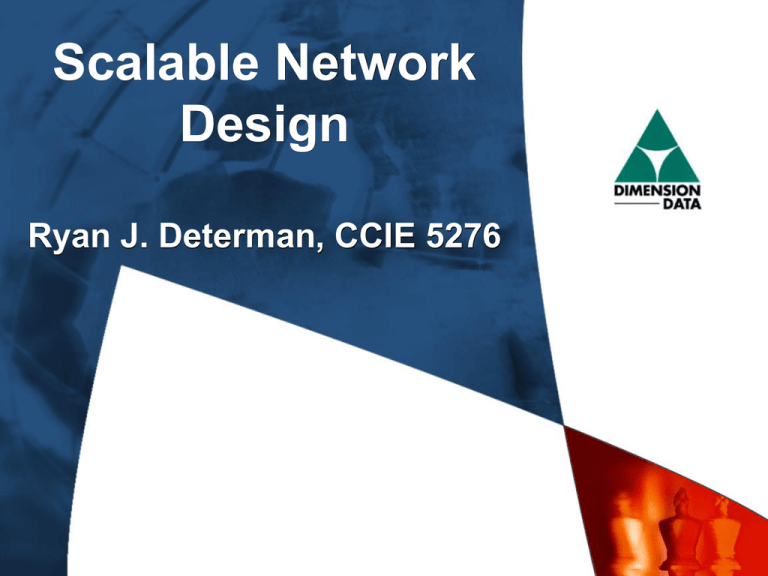
Scalable Network Design Ryan J. Determan, CCIE 5276 Copyright 2002 DDLS Internetwork Design Goals • • • • • Functionality Scalability Adaptability Manageability Cost effectiveness • Basic trade-off in network design is cost versus availability • Recurring costs tend to predominate Characterizing Scalable Internetworks Scalable internetworks need to be: • Reliable and available • Responsive • Efficient • Adaptable • Accessible but secure The Cisco Design Model Core Distribution Access The Core Layer The Core is responsible for optimized transport between remote sites • No routing • Load sharing / Efficient use of bandwidth • Standards based technologies • Don’t be cheap! The Distribution Layer The Distribution Layer is responsible for Layer 3 resiliency • Company resources and new services • Routing peers • Filter and summarize! • Inbound security and policy • Addressing: private or public The Access Layer The Access Layer is responsible for connecting logical workgroups to backbones • User segmentation • Isolate traffic to/from the workgroup Designing The Core Layer 1 predetermines network success • Worth its weight in copper? • Not a good place for cost efficiency • Keep it simple and standard • Layer 1 affects all other layers Core Design Choices ATM • • • Good if available Can be expensive Built in QoS mechanism Point-to-Point Links (T1’s, OC3’s, etc) • • • Best if available and affordable Always expensive Nothing built in Core Design Choices (cont.) Frame Relay • • • Useable but not favorable Always available Can perform some limited traffic shaping Ethernet/LAN • • • Best choice if applicable 10mb, 100mb, 1000mb GigE, FastE, FDDI Designing the Distribution & Access Layers A good Layer 2 design can hide Layer 1 problems from Layer 3 • Design for redundancy • Do you know who your root bridge is? • Spanning Tree is your friend & foe How redundant are you? A fast converging, redundant Layer 2 network will prevent Layer 3 flaps • Use multiple trunks utilizing different blades • Don’t mix and match standards (ie 802.1Q & ISL) • HSRP Root Bridge? Proper Layer 2 design denotes a root bridge • Defines STP metric for algorithm • Should be the ‘most’ redundant • Commonly forgot Spanning Tree STP should provide fault tolerance, not loop avoidance • Designing ‘looped’ layer 2 networks is beneficial • Should have ‘primary’ path and secondary • PVST gets around down time • Tweak the STP protocol (timers, cache, diameter) Hot Standby Routing Protocol HSRP provides Access Layer fault tolerance for hosts • Cisco proprietary solution (VRRP is RFC) • Allows multiple gateways to respond • Only need to configure 1 gateway • No IRDP HSRP (cont) HSRP in action: I need to get to 172.16.3.127. Use MAC address 0000.0c07.ac2f. Router A Priority 200 172.16.10.82 0010.f6b3.d000 Virtual Router 172.16.10.110 Router B Priority 100 172.16.10.169 0010.0b79.5800 0000.0c07.ac2f Core File Server A 172.16.3.127 Designing Layer 3 Let Layer 3 make the decisions • Design for layer 3 switching (FS, Netflow, CEF) • Scalable routing protocols (OSPF, BGP) • Routers route and firewalls firewall • Public vs. private addressing and NAT • Plan for ‘special’ routers Switching at Layer 3 Different switching technologies allow for faster path choice • Fast Switching (route cache) • NetFlow (IP pair based flow with ACL awareness) • CEF (express forwarding using a FIB) • Be careful of the recursive lookup Scalable Routing Protocols Choose the correct protocol • Static routes are not evil • OSPF for small to medium IGP’s • ISIS for large IGP’s • BGP for internet routing policy Static Routes Multiple static routes can provide: • Load balancing • Fault tolerance • Good method for BGP advertisements Designing OSPF OSPF is stable and efficient in a properly designed network • Watch for limits: 50 areas, 3-4 areas per router • Summarize at area borders • Implement OSPF features when possible OSPF Features Configurable OSPF features: • Stub, totally stub and not-so-stubby areas • LSA pacing • Multiple default-gateways by changing default-cost • External type 1 • Demand circuits (doesn’t have to be a DDR link) Designing BGP BGP is only desirable when you have multiple internet connections • Use loopbacks and statics • Do you need an internet routing table? • Use IGP to get ‘out’ to the internet • Use BGP to get traffic ‘in’ • Let the ISP do the work BGP features Configurable BGP features: • Know your attributes (Med, LP, community) • Default originate • Many filtering options (as-path, prefix, dist.) • Large scale: route reflectors and confederations • Route dampening Security at Layer 3 Routers connect & firewalls protect • Standard ACL’s are OK • Use routers for choke points • Use firewalls for security and NAT • Firewall IOS is not a firewall Addressing Design At some point you must NAT • Proper NAT design helps security & implementation • Let the Firewalls translate addresses • Should have distinct ‘line’ of addressing • Use NAT for services and PAT for users Special Routers Router features change quickly, but your design should not • Design with ‘router only’ routers • Design for special purpose/IOS routers to support changing services • Don’t hope for the ‘perfect’ IOS • Run GD code on ‘router only’ routers Designing Layer 4+ I thought network design ended at L3? • What about the services and servers • Content delivery design • CSS, Cache Engine, Content Engine Changing Services Chances are the services your provide as a business model reside on your network • Don’t design yourself out of business • Design for single points of security • Have a place to ‘sniff’ traffic Content Delivery Networks A new type of design has emerged: Content Delivery • How do I get my content to my customer quickly, reliably, and accurately? • How can I support 20 million hits per day? • Can I offload any server traffic? Content Delivery Networks (cont) Making content more available • Push the content to the edge • Load balance mirrored content • Creative DNS solutions Content Delivery Networks (cont) Content delivery hardware and features • Cache Engine (cache’s local servers static content and offloads server of these requests) • Content Engine (provides web services) • Content Smart Switch (glue that connects it all together) Content Smart Switch The CSS is a multi-service box • Can switch/route traffic on any layer 1 - 7 • Can provide DNS server functionality • Can replicate web updates to all mirrored sites • Can load balance to local or remote servers based upon user definable criteria Questions? Contact Information: Ryan J. Determan, CCIE 5276 Ryan.Determan@us.ddls.com 1.800.569.1894
